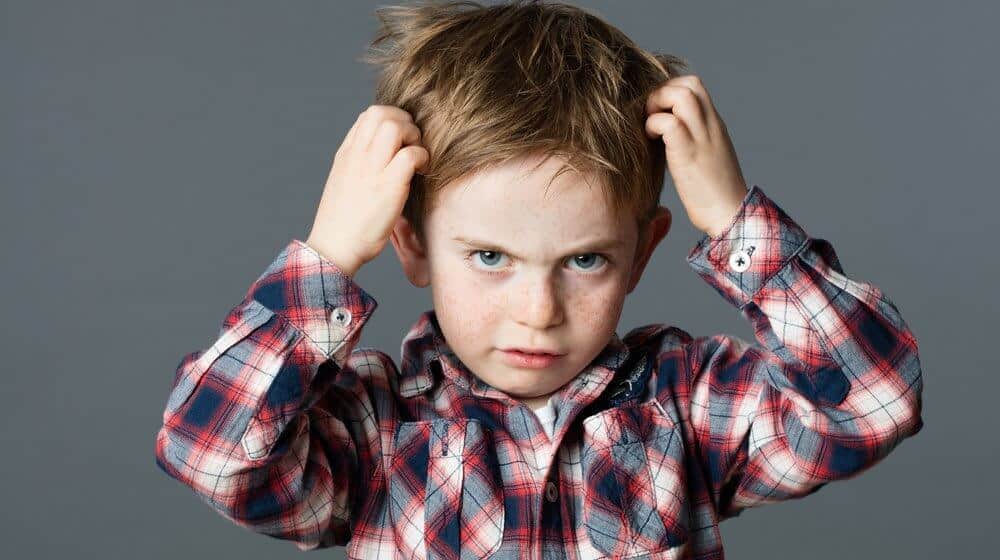
With my kids in school, it was only a matter of time until one of them came home with lice. I’m sure you can relate whether you were the child who got to sit while adults picked through your hair with a fine-tooth comb, or whether you’ve been the parent who got a phone call from the school office. Of course, immediately following, I got many “helpful” suggestions of chemically based treatments that could help get rid of the pests.
While I thanked everyone for their advice, I did some research on my own, and found that there are many natural treatments for lice. We didn’t need to use all of them, but with students going back to school soon, I wanted to you to be armed and ready in case this year, you’re the lucky parent.
1. Break Out the Fine-Tooth Comb
There was a reason your parents, teachers, nurses, and doctors used a fine-tooth comb — because it was effective. While there hasn’t been extensive research done to back up this traditional first step, there is enough of a difference that parents across the world use this as their go-to treatment.
The goal of wet-combing is to remove lice and nits, which are the egg or young louse. They can be difficult to differentiate from dry skin or dandruff flakes, so it’s important to learn the difference. The oval-shaped nits are typically stuck on one side of the hair, often along the hairlines. They might also be moving. Look for white spots for the nits, or tiny black dots for the lice, or check out this look at both that lice911 put together.
Wet the hair, and add a lubricant, like conditioner or oils. Once you’re wearing gloves, comb all of the hair, from the roots at the scalp to the very ends, at least twice a day for three to four days a week. The process may take a few weeks, and you should continue to do so for two to three weeks even after the lice are gone.
Even if you use other treatments from this list, nitpicking should accompany each of them, as nit removal is really the only true way to get rid of lice.
2. Opt for Olive Oil
A great cooking and conditioning agent, olive oil is a top choice for many who are looking to get rid of head lice. The thick oil fills the breathing holes of lice, causing them to suffocate and die. Since lice can go for hours without breathing, cover the hair with a shower cap to make sure it completely penetrates. The next morning, you should comb the hair to remove any dead lice and loosened nits.
The olive oil will also help to condition hair, making it easier to come and repel lice.
How to Kill Ticks Naturally
Keep your family safe from Lyme disease...
3. Good Ole’ Garlic
If you like the smell of garlic, you might be in luck. That pungent odor is known to suffocate and kill lice. Start by grinding up 10 garlic cloves, and mixing them with three teaspoons of lime juice. Cover the scalp with the mix, and let it sit on the hair for about 30 minutes. You can also mix garlic juice, lemon extract, and green tea with shampoo and conditioner. Let that sit on your hair for about 30 minutes. Do this weekly for about two months.
4. Turn on the Heat
Heat is a highly effective way to get rid of both live lice and growing nits. Studies have shown that direct heat can remove almost 98 percent of nits and about half of the living lice. Once you’ve washed your hair, use a hair dryer to put direct hot air all over the scalp, focusing on the areas that have high concentrations of nits.
5. Essential Oils May be Essential
Tea tree oil is a great insecticide, and also has many antibacterial properties. Mix one teaspoon with one ounce of shampoo and three tablespoons of olive or coconut oil. Coat the hair, and then put a shower cap on for about 30 minutes. Follow it up with a hot water rinse for the hair, and then comb for nits. When mixed with lavender oil, some studies show a 97.6 percent success rate. See our article on where to buy essential oils to find tea tree and lavender oils.
Or, check out some of these natural remedies to get rid of lice:
Our Top Recommendation
Almost regardless of which insect is infesting your home or yard, our top recommended solution is the same. Cedar oil is a safe, non-toxic and all natural solution for killing and repelling most insects.
Cedar oil does not harm beneficial insects like bees and butterflies, but it is a contact killer and effective repellent for most insects you’d want to get rid of. See this article to learn more about cedar oil or to see the full range of cedar oil products, click here.
6. Go for a Swim
Or take a long bath. Some people have tried submerging their hair in water for hours at a time, with varying levels of success. Remember, lice can live for hours without breathing, so drowning lice will take several hours, and chlorinated or chemically treated water doesn’t kill or spread lice.
7. Follow Sharing Standards
Whether you have clean or dirty hair, you can still be affected by lice. Refrain from sharing combs and brushes, hats, or other head coverings to reduce the risk of spreading lice.
8. Style the Lice Away
A very thick, extreme-hold type styling gel that stiffens hair, or even petroleum jelly has also been a popular choice for killing live lice. It follows the same suffocation theory as the olive oil, so the treatment is the same. Slather the gel or petroleum jelly all over the scalp, and cover with a shower cap. Wash your hair in the morning and comb for nits. Check the scalp in a few days, and repeat about a week later.
9. Make Mayo a Choice
Again, the high fat content and thick, creamy consistency of mayonnaise can be used like olive oil or styling gel to fill the breathing holes and cut off the air flow for the lice, causing them to suffocate. Use a full-fat mayonnaise — or even one made with olive oil — and cover the scalp and hair before tucking it inside a shower cap. When you wake up in the morning, wash hair and, while it’s still damp, comb the hair to remove dead lice and nits. Again, do this treatment about a week later.
10. Seek Out Sesame Seed Oil
Like tea tree oil, sesame seed oil has many antibacterial, insecticidal, and antifungal characteristics. Rinse your hair with vinegar, and then apply a mixture of sesame seed oil with neem oil, tea tree oil, eucalyptus, rosemary and lavender essential oils. Cover with a shower cap overnight, and then wash and comb hair in the morning.
11. Shrink-wrap the Scalp
No, you’re not going break out the plastic wrap, but you will need heat. This method, which was tested on 133 subjects in two trials, showed a 96 percent cure rate and 94 percent remission rate with no adverse effects for any of the patients. Use a non-toxic lotion or cleanser, free of neurotoxins, and slather the product all over the hair, and then comb the hair from scalp to ends several times, removing as many lice and nits as possible. Then, dry the hair with the product still in the hair. The lotion suffocates the living lice, and the heat causes the lotion to make a film that keeps air from entering.
12. Opt for Other Essential Oils
Other oils, like anise, ylang ylang and nerolidol, might be toxic for lice and their eggs, helping to hasten their death.
13. Vinegar
A top choice for natural household cleaners, vinegar is a great option for removing lice. Skip the fruit-based vinegars, like apple cider vinegar, which contain natural sugars and can leave hair feeling sticky, and pull out plain white vinegar. You can use 100 percent vinegar, or dilute it with water, as the concentration of acetic acid not only breaks down the sticky substance that holds the eggs to the hair shaft but also helps to get hair wet and ready to be combed.
14. Salt and Vinegar: More than Potato Chips
Mix up equal parts of salt and vinegar until the salt has dissolved, and spray it on the hair until the scalp and all hair shafts are wet. Let the mixture dry on the hair, and then coat with coconut or olive oil, and cover with a shower cap overnight. In the morning, wash your hair and then comb out the hair.
15. Mixing Oil and Vinegar
If you want to try another combination, rinse the hair with vinegar, and then cover the hair and scalp with olive or coconut oil for at least eight hours. Follow the same steps: wash, comb, and dry hair.
16. Bring Out the Butter
Full-fat melted butter, like mayonnaise, can also be used to suffocate or smother lice. Coat the hair and scalp with butter, cover with a shower cap, and then wash and comb through hair in the morning.
17. All About AirAllé
A 60-minute treatment with this vacuum-like machine can help to remove 99.2 percent of nits and by both pushing out hot air to dehydrate the lice and eggs, and brushing the hair. The AirAllé can only be used by a certified operator.
How to Kill Ticks Naturally
Keep your family safe from Lyme disease...
18. Clean the Environment
While you’re treating the scalp, make sure you’re also cleaning things that will come in contact with the scalp, like combs and brushes, as well as pillowcases and bedding, hats, towels, and scarves in very hot, soapy water. Items that can go in the clothes dryer should be dried on the highest heat setting. Consider taking car seat covers off, or cushion and furniture covers. Anything that can’t be washed should be put in a black garbage bag and tied shut for two weeks.
19. Be Consistent
Lice lay eggs that grow every ten days, so by washing and removing them every seven days, you’re removing the chances of the lice reproducing. Stick to a schedule and you’ll have much greater success.
20. Don the Dishwashing Liquid
The grease- and grime-fighting properties of dishwashing liquid are valuable tools for not only dissolving the sticky substance that holds nits to hair, but also removing the different natural treatment options you’ve used to get rid of lice.
21. Be Patient
Lice may be gross, and a nuisance, but they aren’t going to cause a health risk. Remember, they’ve been surviving in hair for much longer than you’ve been trying to treat them. Stay calm and prepare yourself for several weeks of treatment.
I hope you found this list helpful for treating lice naturally — I know that for my family, I’d much rather use natural products than products made potentially harmful or chemically-based ingredients. What do you prefer? I’d love to hear about any natural treatments you’ve tried. Share your stories in the comments and if you liked this article, please feel free to share!
